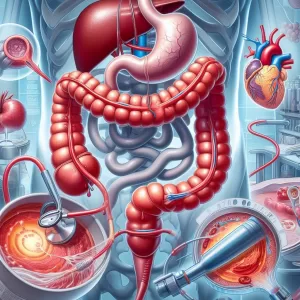Qu'est-ce que l'hémorragie sous-arachnoïdienne ?
[wp_show_posts id=”8626″]
**Q: What is Subarachnoid Hemorrhage?**
**A:** Subarachnoid hemorrhage (SAH) is a life-threatening condition that occurs when there is bleeding in the subarachnoid space, which is the area between the brain and the thin tissues (meninges) that cover it.
**Q: What Causes Subarachnoid Hemorrhage?**
**A:** The most common cause of SAH is a ruptured brain aneurysm, a weak area in an artery that supplies blood to the brain. Other causes include:
* Head injuries
* Blood clotting disorders
* Meningitis
* Arteriovenous malformations (AVMs)
**Q: What are the Symptoms of Subarachnoid Hemorrhage?**
**A:** Symptoms of SAH can include:
* Sudden severe headache (“thunderclap headache”)
* Nausea and vomiting
* Sensitivity to light (photophobia)
* Seizures
* Loss of consciousness
* Confusion
**Q: How is Subarachnoid Hemorrhage Diagnosed?**
**A:** SAH is diagnosed through:
* **Computed tomography (CT) scan:** A 3D X-ray that can detect bleeding in the brain
* **Lumbar puncture (spinal tap):** A procedure that collects cerebrospinal fluid from the lower back and checks for blood
**Q: What are the Risk Factors for Subarachnoid Hemorrhage?**
**A:** Risk factors for SAH include:
* Smoking
* High blood pressure
* Diabetes
* Family history of SAH
* Use of anticoagulants or antiplatelet drugs
**Q: How is Subarachnoid Hemorrhage Treated?**
**A:** Treatment for SAH may involve:
* **Emergency surgery:** To stop the bleeding
* **Endovascular coiling or stent placement:** Procedures to seal or repair the aneurysm
* **Medications:** To control pain, seizures, and prevent vasospasm (narrowing of arteries in the brain)
* **Rehabilitation:** To regain function lost due to the hemorrhage
**Q: What is the Prognosis for Subarachnoid Hemorrhage?**
**A:** The prognosis for SAH depends on the severity of the bleeding and the timeliness of treatment. Immediate treatment can improve survival rates. However, the condition remains life-threatening, and complications can include:
* Stroke
* Brain damage
* Seizures
* Hydrocephalus (excessive fluid buildup in the brain)
**Q: How Can I Reduce My Risk of Subarachnoid Hemorrhage?**
**A:** Reducing your risk of SAH involves:
* Quitting smoking
* Controlling your blood pressure
* Managing your diabetes
* Getting regular checkups for any predisposing conditions
**Q: What is Subarachnoid Hemorrhage?**
**A:** Subarachnoid hemorrhage (SAH) is a life-threatening condition that occurs when there is bleeding in the subarachnoid space, which is the area between the brain and the thin tissues (meninges) that cover it.
**Q: What Causes Subarachnoid Hemorrhage?**
**A:** The most common cause of SAH is a ruptured brain aneurysm, a weak area in an artery that supplies blood to the brain. Other causes include:
* Head injuries
* Blood clotting disorders
* Meningitis
* Arteriovenous malformations (AVMs)
**Q: What are the Symptoms of Subarachnoid Hemorrhage?**
**A:** Symptoms of SAH can include:
* Sudden severe headache (“thunderclap headache”)
* Nausea and vomiting
* Sensitivity to light (photophobia)
* Seizures
* Loss of consciousness
* Confusion
**Q: How is Subarachnoid Hemorrhage Diagnosed?**
**A:** SAH is diagnosed through:
* **Computed tomography (CT) scan:** A 3D X-ray that can detect bleeding in the brain
* **Lumbar puncture (spinal tap):** A procedure that collects cerebrospinal fluid from the lower back and checks for blood
**Q: What are the Risk Factors for Subarachnoid Hemorrhage?**
**A:** Risk factors for SAH include:
* Smoking
* High blood pressure
* Diabetes
* Family history of SAH
* Use of anticoagulants or antiplatelet drugs
**Q: How is Subarachnoid Hemorrhage Treated?**
**A:** Treatment for SAH may involve:
* **Emergency surgery:** To stop the bleeding
* **Endovascular coiling or stent placement:** Procedures to seal or repair the aneurysm
* **Medications:** To control pain, seizures, and prevent vasospasm (narrowing of arteries in the brain)
* **Rehabilitation:** To regain function lost due to the hemorrhage
**Q: What is the Prognosis for Subarachnoid Hemorrhage?**
**A:** The prognosis for SAH depends on the severity of the bleeding and the timeliness of treatment. Immediate treatment can improve survival rates. However, the condition remains life-threatening, and complications can include:
* Stroke
* Brain damage
* Seizures
* Hydrocephalus (excessive fluid buildup in the brain)
**Q: How Can I Reduce My Risk of Subarachnoid Hemorrhage?**
**A:** Reducing your risk of SAH involves:
* Quitting smoking
* Controlling your blood pressure
* Managing your diabetes
* Getting regular checkups for any predisposing conditions
Un commentaire
Laisser un commentaire
Articles populaires








Subarachnoid hemorrhage (SAH) is a life-threatening condition in which blood accumulates in the space between the brain and the skull. SAH is most commonly caused by a ruptured aneurysm, a weak spot in a blood vessel wall. When an aneurysm ruptures, it can cause severe bleeding and damage to the surrounding brain tissue.